How Roofers Are Increasing Leads, Sales & Revenue Online
The needs of consumers are changing—fast. Gone are the days of using the Yellowpages to find the nearest roofing company. In it’s place: digital marketing for roofers.
You see, today’s digital-first consumers rely on the internet to find local businesses and educate themselves about what roofing services they need.
They don’t turn to the phone book.
Ask yourself this question…is your roofing website positioned to capture these customers’ attention, or worse, not found on page one of Google at all?
If it’s not, you’re losing leads and sales to your competitors, guaranteed.
Why?
Because you need to advertise your roofing company where modern consumers spend their time—online.
The Modern Online Buyer’s Journey: Understanding Digital-First Consumers
Modern homeowners seek instant gratification, and the digital transformation sparked an I-need-it-now economy. These days, your customers expect an immediate response to appointment requests and phone messages, a frictionless customer experience, and top-notch, next-day service.
Today’s consumers no longer follow a linear path throughout their buying journey.
Instead, they hop around the internet, using every tool and platform at their fingertips to find a local roofer.
The modern sales funnel is a looping journey full of twists and turns as consumers follow their own, personalized path to purchase:
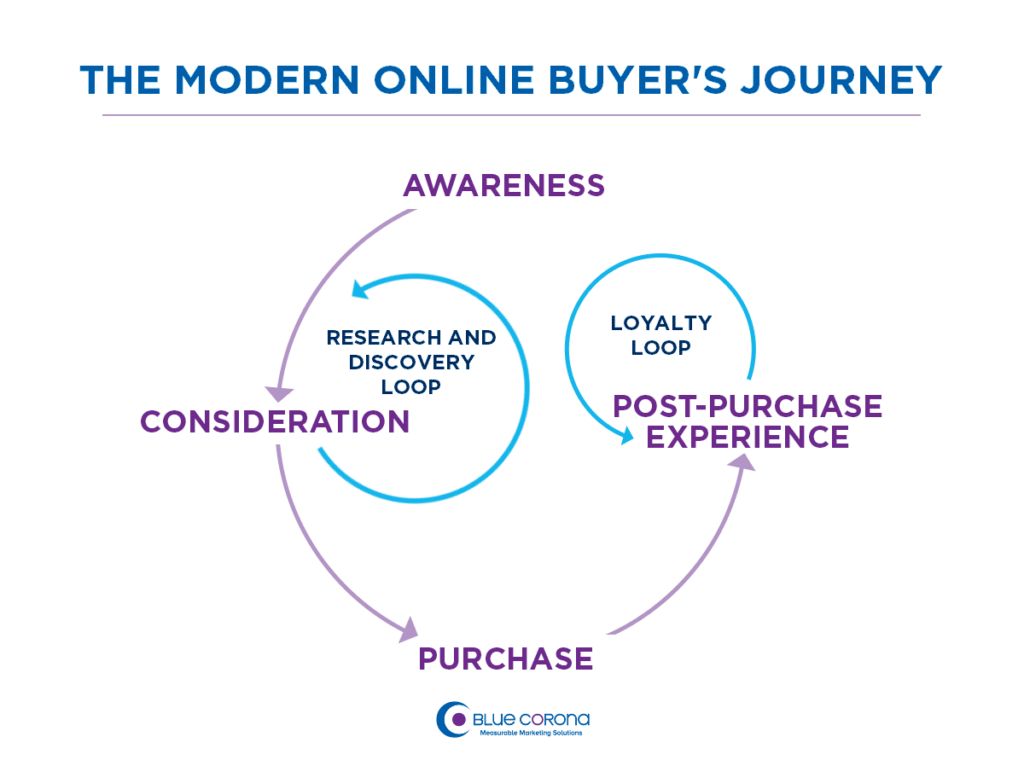
Let’s pretend our consumer is Mike, a 45-year old homeowner with a wife, family dog, and three children.
- It’s 6:00 pm and raining outside. Mike notices a water stain on his master bathroom’s ceiling. – Awareness
- Mike takes his iPhone out of his pocket and uses Siri’s voice search to Google “water leak upstairs.” – Consideration
- Mike reads two blogs from roofing companies that summarize potential reasons why he has a water leak. – Consideration
- Mike watches a YouTube video from a local roofing company explaining the potential causes of his leaky roof. – Consideration
- Mike asks his neighbors on the Nextdoor app and his Facebook friends for roofing company recommendations. – Consideration
- Mike calls three roofing companies for an estimate. – Consideration
- Mike signs a contract and schedules his roof repairs. – Purchase
- After Mike’s roof is repaired, the roofing contractor sits down with him to explain the work completed and answer his family’s questions. – Post Purchase Experience
- Mike leaves a review for his roofing company on Google My Business. – Post Purchase Experience
- Mike opts-in to receive monthly email newsletters from his roofing company to learn about new products and services. – Post Purchase Experience
If you want more roofing leads, booked jobs, and repeat customers, you need to connect with customers along every stage of this new looping journey.
9 Proven Roofer Marketing Strategies GUARANTEED to Increase Your Leads & Sales
Below, we’ve outlined 9 roofer marketing strategies proven to generate more website visits, calls, leads, and revenue for your business—starting with your website.
Follow these tips and tricks and you’ll be well on your way to growing your business.
Have questions? Overwhelmed? No problem—we got you. Contact us online for more information about Blue Corona’s roofer marketing strategies.
1. Build a Better Roofing Website
Your website is the digital face of your business, and first impressions count. According to a Stanford study, 75% of people judge a company’s credibility based on website design. You need a killer website to make your roofing company stand out from your online competitors.
Website Speed Matters

Internet users are impatient. They want information NOW, and there’s no excuse for delays. Almost half of people expect a website to load within two seconds, and with every additional second of wait time, there’s a 7% reduction in conversions. A slow website will send users elsewhere and cost you money, so make sure it’s fast.
Mobile-Friendly Means Customer-Friendly
A mobile-friendly site in 2020 isn’t optional; it’s mandatory. Today, more than half of all internet users use mobile devices for internet browsing, with that number expected to rise to almost 75% by 2025. It should be easy for customers to find and hire you for roofing services, so optimize your site for their preferred devices.
Designing your website to work on mobile devices is so crucial that mobile-friendliness is a ranking factor on Google. Sticking with your old, static desktop site will hurt your search engine rankings and cause you to lose keyword rankings to your competitors online.
Make Your Website Secure
The internet can be a dangerous place, and users want to know their information is safe. Securing your website with HTTPS, as opposed to an unsecured HTTP, will show users that you take internet security seriously. Studies have shown that 82% of people won’t even browse an unsecured website. Upgrading your website to HTTPS will also boost your rankings on Google.
Craft Your Website for Conversions
Your website isn’t just a place to find information; it needs to convince customers to purchase your roofing services. It should be easy to navigate and actively guide users through the buyer’s journey. Use design aspects like:
- Include sticky headers (the top menu is static while scrolling)
- Place your phone number at the top-right of the header
- Put a contact form on every page
- Add trust builders like customer reviews, certifications, team photos/bios, testimonials, etc.
Provide them with the information they need, earn their trust, and make it simple to get in touch.
2. SEO for Roofing Companies: Outrank the Competition on Google
In today’s world, search engines are the all-knowing, all-seeing entities that people trust for information. When people need roofing services, 97% head to the internet. If you want to boost your roofing company’s digital marketing reach, you need to rank well on search engines like Google.
Search engine optimization (SEO) is organizing your website layout, content, and structure to be friendly to search engines and build long-term equity. The more the search engine likes your website, the higher it’ll rank.
The Three Pillars of SEO
SEO is a complicated science that’s always evolving. Currently, there are over 200 different factors that Google takes into consideration when ranking websites that can be categorized into three SEO pillars:
1. Website Code and Structure
The way your website is structured has a big impact on SEO. Technical considerations like page load speed are known to be SEO ranking factors, with quick loading pages earning better SEO value. This is a matter of usability. Google prioritizes web pages that support a simple, efficient browsing experience for users, which is why accessibility issues like mobile-friendliness and security also generate SEO value.
The same rule applies to how your website’s internal linking structures are set up. SEO crawlers use links on your website as reference points to determine each page’s relationship to one another and how relevant a page may be to a given topic. A clear linking strategy supports SEO-friendly web architecture and makes it more likely that your pages will appear in search results.
2. Onsite Content
Once your website is scannable, it needs to have the right content. Search engines rank content based on six primary factors:
- Quality – Content needs to be well-written and informative.
- Keywords – Include target words and phrases in your content.
- Freshness – Content needs to be timely. Constantly refresh or retire old pages.
- Multimedia – Set your content apart with video, images, and audio. Be sure to use alt tags.
- Answers – Create content to answer popular industry questions that are likely to get searched for by your target audience.
- Depth – Informative, detailed content produces better marketing results than broad overviews. Dig deeper.
It doesn’t matter if you’re creating a landing page or a blog, all website content should follow these guidelines to rank well on search engines.
3. Offsite Factors & Reviews
Search engines don’t rank websites solely based on the content and structure of the webpage. They also consider how users perceive your website and your company. Google scours the internet for reviews, backlinks, and social signals and uses that information to determine your website’s popularity, trustworthiness, relevance, and authority. These that “vouch” for your website and your company will earn you higher search result rankings.
3. Tighten Up Your Local SEO
Standard SEO practices help you rank for worldwide search results, but as a roofing company, don’t you want to focus on people in your service area? That’s where local SEO comes in.
Local SEO helps you rank in the Local Pack, otherwise known as the “maps listing” on Google. When someone in your service area searches for “roofing companies near me,” local SEO is what will put your company at the top of the results.
There are two key aspects to local SEO: NAP citations and reputation.
NAP Citations
To rank higher in a specific region, search engines need to know your location. This is done with consistent NAP citations (name, address, phone number) across online directories. You want online listings like Google, Facebook, and Yelp to have the same information. The more directories that have your information, the stronger your local SEO will become.
It’s also important for every directory to have a link to your website. High-quality link building is an essential part of SEO, and online directories are great for generating backlinks.
Review Generation and Reputation Management
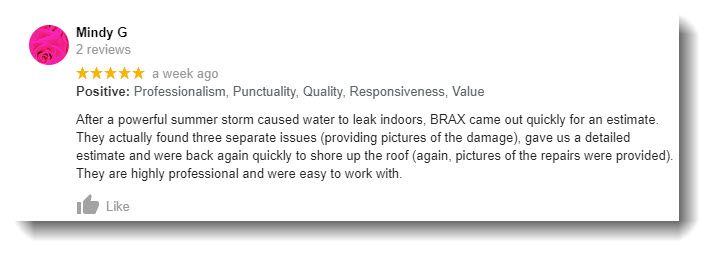
Search engines want to give users the best answers to their questions. If someone searches for “top roofing company near me,” Google searches the internet for reviews and offers results based on the search.
That’s why it’s so important to include review generation and reputation management into your roofer marketing strategies.
Of course, Google isn’t the only one looking at reviews. Studies have shown that 82% of consumers read online reviews before purchasing a product or service, and most read at least ten reviews before feeling like they can trust a company. If you have few or negative reviews, it doesn’t reflect well on your business.
Keeping up with reviews and managing your business’s online reputation is a huge task, and it can help to have a marketing expert (like Blue Corona) on your side to help manage your local SEO.
4. Invest in Content Marketing & Blogging to Generate More Roofing Leads
How does blogging fit into roofer marketing? Isn’t that just for young people wanting to rack up likes on social media? Not at all! Blogging is a great way to generate leads. You can create loads of content to boost SEO, increase your website traffic, and establish your business as THE AUTHORITY for roofing services.
Increase Website Traffic
Google ranks web pages, not websites. So, the more pages you have on your website (aka. content), the more likely you are to rank for specific keywords. Blogs are a great way to create fresh web content that targets the words and phrases your customers search for.
For example, homeowners don’t always search for “roofer near me.” They might ask, “why is my roof leaking,” “signs it’s time for a new roof,” or “what’s involved in a roof inspection?” If you want your business to appear at the top of the Google search results, you need content to address all the questions roofing customers might ask. Answer more questions; get more leads. It’s as simple as that.
Statistics show that a regularly updated blog increases the chance of a website ranking on search engines by a whopping 434% and generates 67% more leads!
Establish Your Authority in the Roofing Industry
Roofing services can be a significant investment, and customers want to work with a company they trust. Establish yourself as an expert in your industry with a blog.
Give website visitors thoughtful, knowledgeable answers to their questions to prove that you know what you’re talking about. Blogging is so effective at establishing authority that 61% of U.S. consumers have purchased a product or hired a service based solely on a blog post.
Once you’ve established yourself as an authority, people will use your website as a resource. They’ll share your pages all over social media and other websites, creating backlinks and increasing your website’s authority—which will boost your search engine rankings. Websites with blogs generate 97% more backlinks than sites without blogs.
Content marketing requires time and effort, but with the leads and online visibility it can bring, it’s an essential part of any roofing company digital marketing strategy.
5. Maximize Search Engine Visibility with Local Services Ads for Roofers
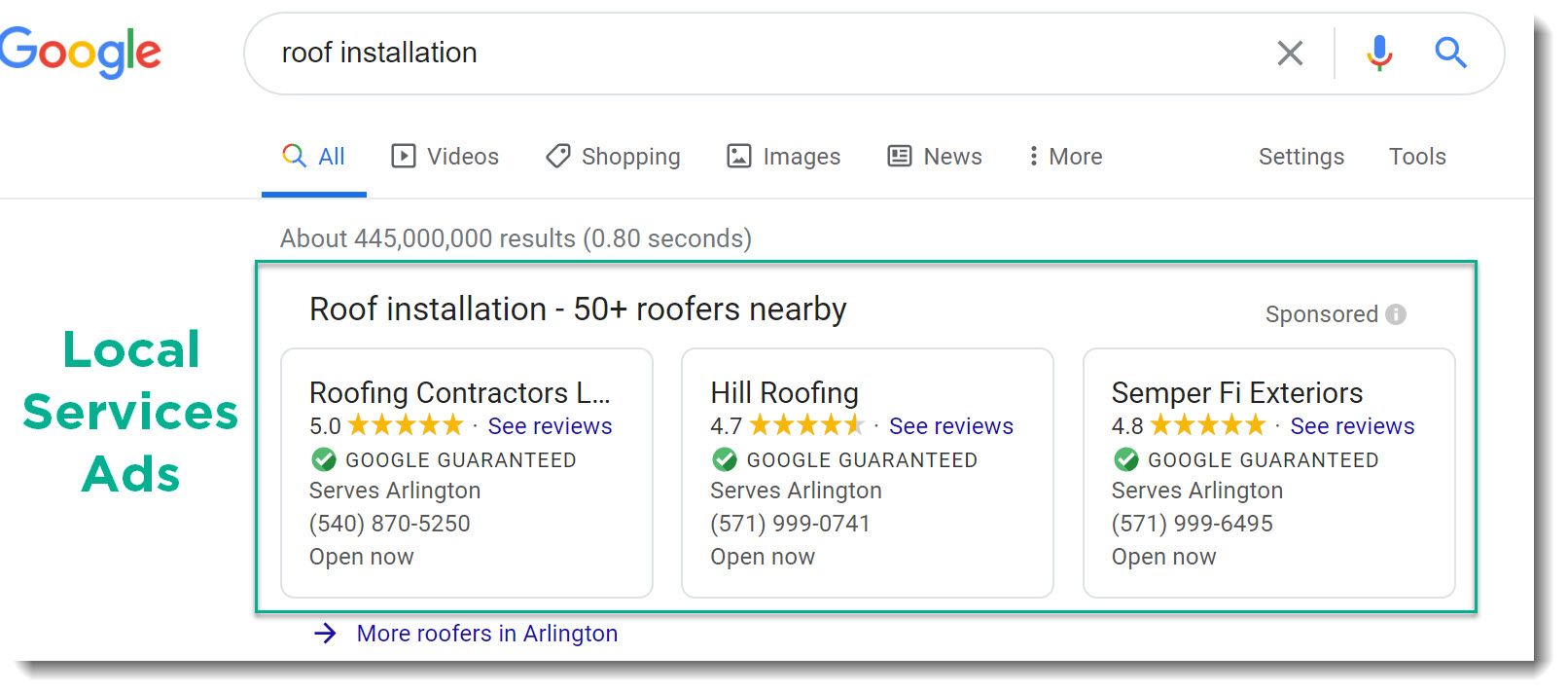
Standard SEO tactics can help your website rank at the top of organic search results, but sometimes, the organic results aren’t at the top of the page! For roofing companies, Google’s Local Services ads (LSA) are the perfect way to maximize search engine visibility.
Local Services ads appear as small windows at the very top of the search results when someone searches for services in an area. Unlike pay-per-click (PPC) ads that provide a website link, Local Services ads are designed for fast action, giving users essential business information like the phone number, location, hours, ratings, and available services to make finding a roofing service quick and easy.
When you purchase a Local Services ad, benefits include:
- A Google Guarantee Badge showing that Google backs your business (increases trustworthiness)
- Placement at the top of the search results
- Boosts in affordable leads – you’re only charged for qualified leads
- Inclusion in voice searches on voice-enabled devices
Visit the Blue Corona blog to learn more about Google’s Local Services ads.
6. Get Roofing Leads Quickly with Pay Per Click (PPC) Ads
Getting a Google Guarantee Badge for your Local Services ad takes some time, so if you’re looking for quick leads, it’s hard to beat pay per click (PPC) ads.
PPC ads are the most common form of paid search engine marketing. Instead of paying a flat fee upfront, you’re only charged when someone clicks on your ad.
Types of PPC Ads
Pay per click ads can be purchased from several providers online with Google Ads as the most popular and Microsoft Ads in a distant second. There are three main types of PPC ads you can choose from to fit your unique roofer marketing goals:
- Search ads – Pay to soar to the top of the search results for specific keywords (although it does the same thing with less effort, this shouldn’t replace organic SEO).
- Display ads – Your ad appears across all partner websites of the provider you’ve chosen. Display ads allow you to select your target market and show your ad on related sites.
- Remarketing ads – Have you ever visited a website and continued seeing ads for that exact site everywhere you go online? That’s remarketing. Remarketing ads follow users who have already shown an interest in your service around the internet to remind them to come back and do business.
Is PPC Worth It for Roofers?
Absolutely, given that the average business makes $2 for every $1 spent in Google Ads.
PPC advertising gives you the unique ability to pay only for the clicks you receive. If you purchase a billboard and get one lead, that’s one expensive lead. In a PPC campaign, you pay for clicks, so you’re not charged for users who overlook your ad without action.
Don’t wait for a Google Guarantee Badge or long-term SEO equity to build your roofing company’s online presence; generate leads immediately with PPC ads. Select your target market, craft your ad, and show up in the most coveted online real estate: the top of the search results.
7. Differentiate Your Brand Online Using Social Media
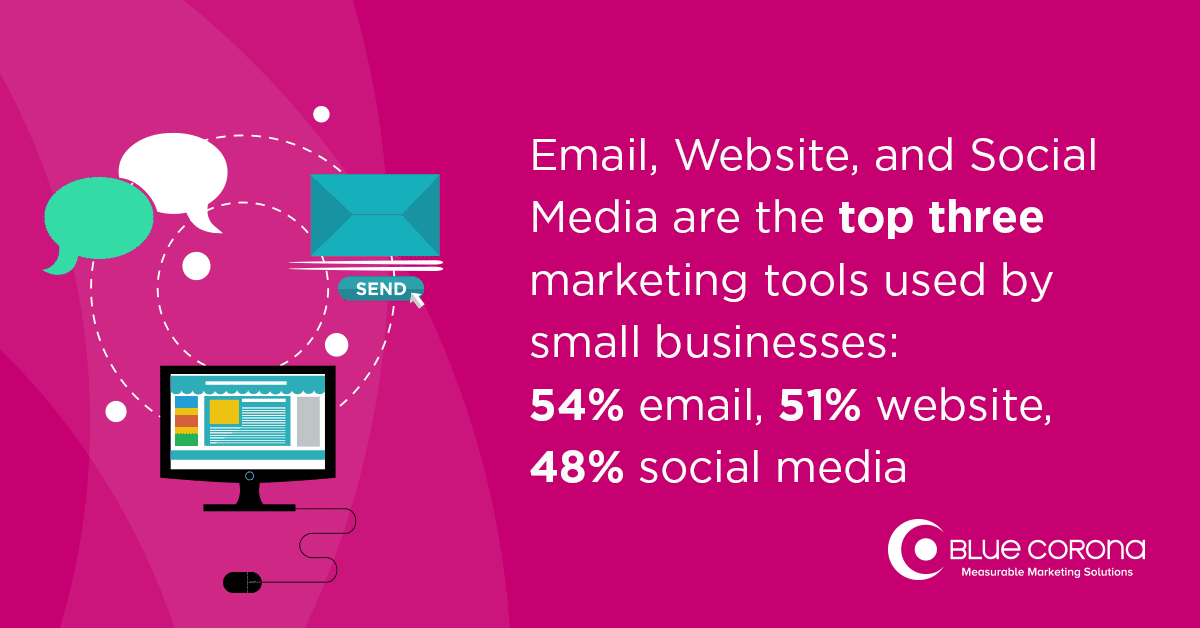
To create the best roofing company digital marketing strategy, you need to know where to find potential customers. Well, they’re all using social media. There are currently worldwide, and over half of them rely on social platforms to research products and services.
Social media is a powerful and affordable brand-building initiative that lets businesses show off their brand’s personality with engaging posts, showcase new products and services, and target specific demographics and regions. It’s free to create a business profile on social media, so there’s no excuse not to use it!
Although it’s free to create social accounts, only your followers will see organic posts. Even if you’re already using PPC ads, paid social media ads can supplement your posts and increase your online reach to a different audience.
Your roofing company needs a Facebook page; there’s no question about it. Facebook is excellent for sharing anything from pictures and videos to text and services. It has the most users of any social media platform, and it’s free to use. You can research industry trends, interact with potential customers, and manage your online reputation. Facebook is a significant source of business ratings.
Instagram is the second most popular social media, becoming more popular than Facebook with younger audiences. It’s highly image-focused and mostly used for sharing photos and videos. Over 70% of U.S. businesses use Instagram for marketing purposes.
Nextdoor
Nextdoor is a social media platform designed for residents to keep up with the happenings in their neighborhoods. What does this mean for roofing companies? You can target individual neighborhoods in your service area!
If you know a neighborhood is reaching a certain age and will need roofing work soon, you can target Nextdoor advertisements directly to homeowners you know will be looking for your services.
LinkedIn is designed for professional networking and is best for attracting commercial roofing customers. Around 80% of all social media B2B leads come from LinkedIn. For commercial roofers, LinkedIn could be the most effective social network for advertising.
8. Get More Leads from Existing Customers with Email Marketing for Roofers
In the age of social media and targeted website advertisements, it might seem like email is a worn-out relic of the past, but nothing could be farther from the truth. Just look at these statistics:
- Average ROI of $42 for every $1 spent (4,200%!)
- 99% of consumers check email daily
- 59% of people say email marketing influences their purchase decisions
- Over 59% of marketing professionals say email is their most significant source of ROI
- Segmented email campaigns can increase revenue by as much as 760%
- Email engagement has increased in the past year
- 90% of emails reach their intended recipient (only 2% of Facebook followers see your posts in their newsfeeds)
- You’re 6x more likely to get a clickthrough from an email than a tweet
Email offers greater insight into your customers’ engagement. You can see which links are clicked on the most and create segmented customer lists to send related follow-up content. Email lets you send the right message, to the right customer, at the right time for massive returns on your investment dollars.
By sending regular emails, you can stay at the top of your customers’ minds, so when they need roofing service, you’ll be the first person they call. It can also be a great way to educate your existing customers about new products and services.
The hardest part of email marketing is getting people to open your emails instead of sending them directly to the trash. Here are some tips on how to stand out in an email inbox.
9. Get More Online Reviews
Making a sale isn’t the end of a your roofing company’s digital marketing campaigns. Once the service is complete, encourage your customers to submit online reviews.

Reviews are important for two reasons. First, Google uses them to rank websites. The better your online review rating, the higher you appear on search results. Second, customers use reviews. In fact, 85% of them trust online reviews as much as personal recommendations from family and friends.
Even if you’ve racked up a bunch of reviews in the past, you need to keep going! Here are some tips for getting more reviews:
- Ask customers for a review after each service
- Encourage them to leave a review in a follow-up email
- Make it easy for customers to leave a review
- Respond to reviews online (both good and bad)
Marketing is cyclical, and online reviews are the bridge that brings your efforts full circle. Once the service is complete, existing customers complete reviews to attract new customers to your brand. The circle of marketing life, if you will.
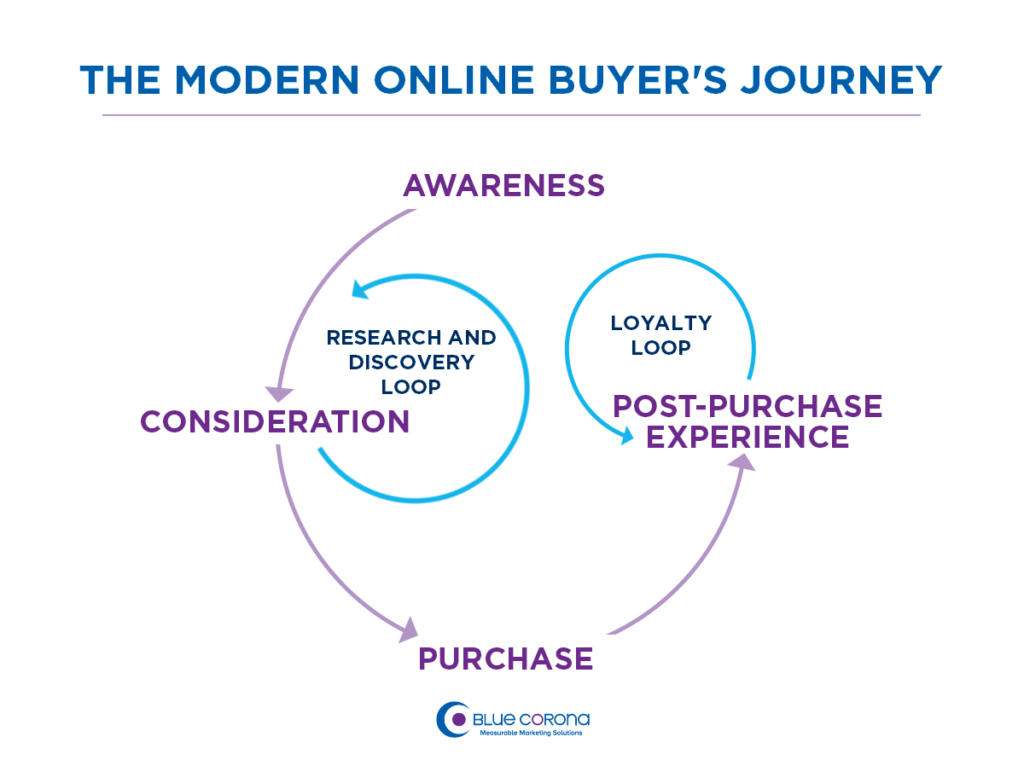
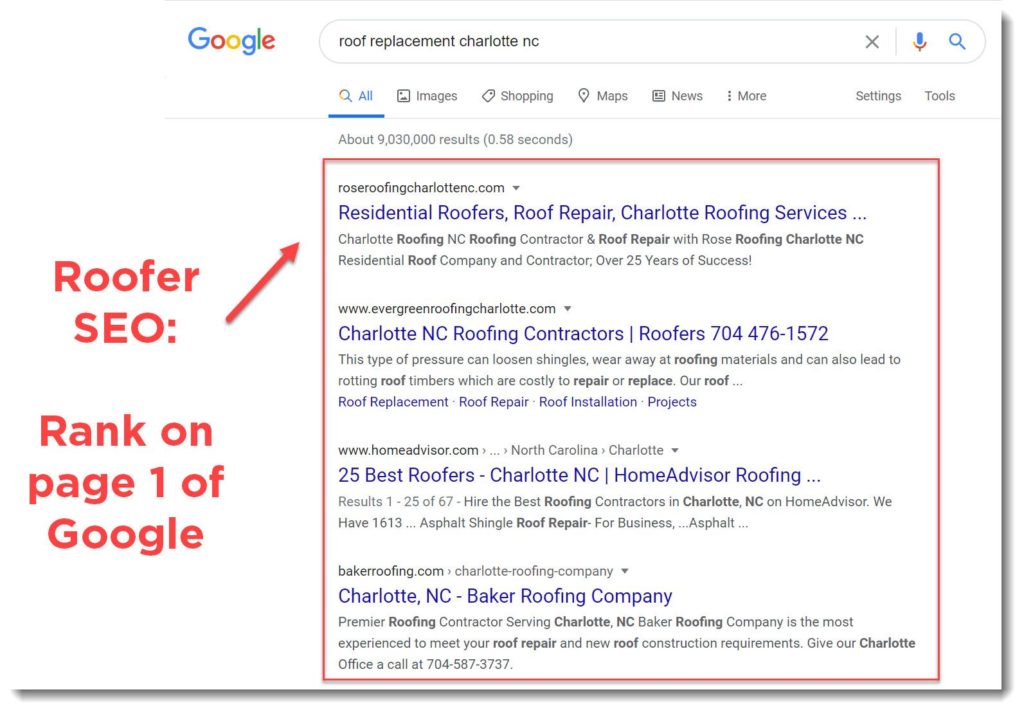
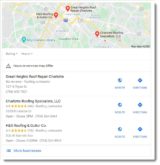
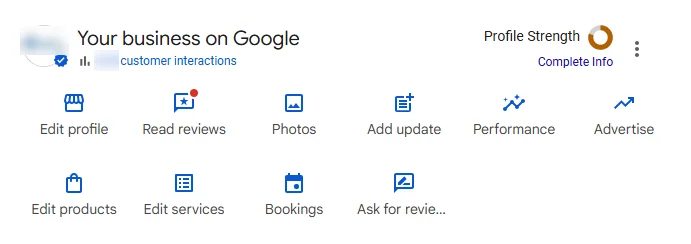



Recent Comments